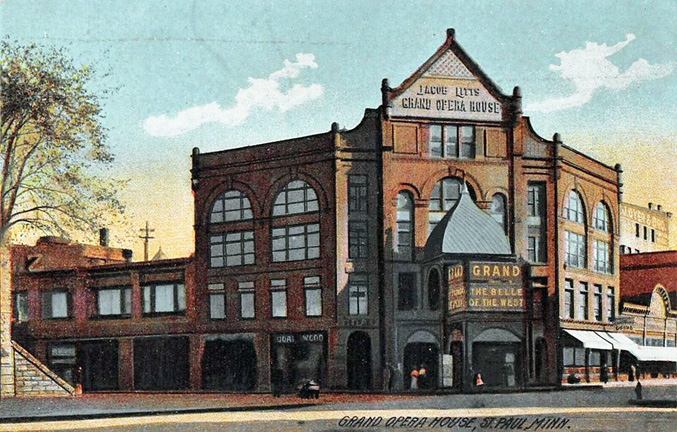Grand Opera House, St. Paul
The first St. Paul Grand Opera House was apparently on Wabasha Street, and burned down in 1888.
The Metropolitan Opera House was built to replace it, opening on December 29, 1890. It was located at 100 E. Sixth Street in St. Paul.
A second replacement was the Grand Opera House, located at 34 E. Sixth Street. It also opened in 1890, by Milwaukee-born Jacob Litt. The Grand Opera House could seat around 1,200 amidst Beaux-Arts finery, including two sets of box seats, a large balcony and moderate-sized stage. Opening day included a speech by the Governor of Minnesota, and attendance by most of the leading families of St. Paul.

Grand Opera House, St. Paul, @ 1910s. From the collection of Mark Youngblood
Not only did the Opera House stage operatic fare, but musicals and legitimate theater as well, during the 1890s and into the first decade of the 20th century. The Opera House was also a venue for boxing matches, including appearances by such legends as John L. Sullivan and “Gentleman” Jim Corbett.
A fire in early 1912 destroyed a portion of the Opera House, but it was rebuilt and reopened later that same year as a burlesque house called the Strand Theater.
Two years later it was closed again and remodeled with interior decor based upon New York City’s Strand Theater. It housed a $5,000 pipe organ, had its own house orchestra, and a colossal electrically- illuminated roof-top sign. The Strand Theater became primarily a movie house, though it still continued to host live entertainment as well.
Very soon after, it received a final name change, as the Garrick Theater, and by 1926 was operated by the Finkelstein & Ruben chain. From the 1920s into the 1940s it was a first-run movie house, and in its early years the Garrick Theatre even had reserved seating and higher prices for box seats.
However, by the end of World War II, the Garrick Theater had definitely seen better days, and was showing B-grade double-and-triple features. Shortly after it closed in early 1950, it was razed to make way for a parking garage.
Research by Bryan Krefft, cinematreasures.org
